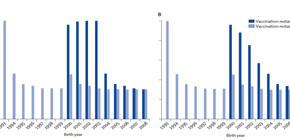
Suspension of encouragement of HPV vaccinations will cause disparities in the incidence of HPV infection, depending on year of birth
A group of researchers led by medical staff member TANAKA Yusuke and Assistant Professor UEDA Yutaka at the Department of Obstetrics and Gynecology, Osaka University Graduate School of Medicine calculated the risk of HPV 16/18 infection in Japanese women at 20 years of age born between 1993 and 2008 according to their year of birth. This group found that if the encouragement of HPV vaccination by the Japanese government does not resume, a group will emerge with a noticeably high HPV 16/18 infection rate, and disparities will be made in the incidence of HPV infection depending on the year of birth.
Summary
In Japan, HPV vaccinations became available to female children aged 13 to 16 with public aid from 2010 and subsequently became routine vaccinations for those aged 12-16 from April 2013. However, the news media reported adverse events to the vaccine repeatedly (although it is not exactly known whether they were actually adverse events) in the spring of 2013, and the Ministry of Health, Labour, and Welfare suspended its active recommendation for receiving HPV vaccinations in June of 2013. As a result, for the fiscal year of 2013, the newly-vaccinated rate for 12 and 13 year olds dropped from “routine” to 1.1 % and 3.9%, respectively.
Despite the statements from expert committees (the Japan Society of Obstetrics and Gynecology, the International Federation of Gynecology and Obstetrics, and the World Health Organization) supporting the safety of HPV vaccination and the necessity for the continued administration of the HPV vaccine in appropriate populations, encouragement for HPV vaccination by the Japanese government has not yet been resumed.
If the current situation continues in Japan, there is deep concern that disparities in the incidence of HPV infection, and resulting future cervical and other HPV-related cancers, may occur, depending on an unfortunate year of birth. Based on this scenario, we herein make certain predictions regarding infection rate for HPV16/18 in Japanese women, as they achieve the age of 20 in the future, depending on their current year of birth. By resuming vaccination encouragement in 2016, the number of “unfortunate outcomes” among female children associated with not receiving HPV vaccines can be kept to a minimum. In other words, this year is the last chance for Japan to minimize the damage in our children. Should vaccination encouragement resume in a couple of years, “female children aged 12-16 during the encouragement suspension period” should at least be included as vaccination subjects.
Figure 1a: Risk of HPV 16/18 infection at 20 years old: HPV vaccination only for female children aged 12-16 when resuming vaccination encouragement
Figure 1b: Risk of HPV 16/18 infection at 20 years old: HPV vaccination for female children aged 12-16 during the encouragement suspension period in addition to “female children aged 12-16 at the time of the encouragement resumption”
Charts were created assuming that “the risk of HPV infection correlates to the rate of experiencing the sexual intercourse without HPV vaccination”, “the risk of HPV16/18 infection at 20 years old among women having sexual intercourse, who were born in 1993, is 1.”, “the rate of experiencing sexual intercourse at the age of 20, 19, 18, 17, 16, 15, 14, 13 and 12 was assumed to be 65%, 55%, 42%, 25%, 15%, 5%, 2%, 1% and 0%, respectively, in evaluating the HPV infection rate.”, “female children were vaccinated at the youngest age during the encouragement period (except 2013)”, “the rate of vaccination among female children aged 13−16 between the years of 2010 was 70%”, “the cumulative rate of vaccination in 2013 among female children aged 12 and 13 was 1% and 4%, respectively.”, “the cumulative vaccination rate after resuming vaccination encouragement among female children is 70%.”, and “the relationship between the vaccination rate and experience of sexual intercourse is independent.”
To learn more about this research, please view the full research report entitled “ Outcomes for girls without HPV vaccination in Japan ” at this page of the Lancet Oncology website.
Related link
